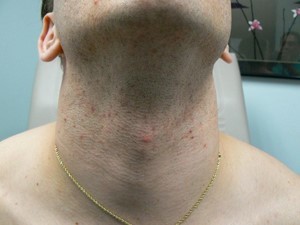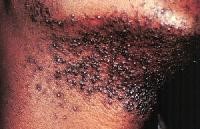 Pseudofolliculitis Barbae, the medical name for razor bumps effects millions of shavers all over the world most of which have a curly hair texture. This disorder – also known as Ingrown Hair-causes extreme inflammation and discomfort when newly growing hair is trapped under the skin. A localized infection forms where the hair has re-entered creating unsightly puss filled pustules that painfully irritate the skin. This problem occurs quite frequently in people who shave with electric or disposable razor blades. If left untreated these ingrown hairs continue to barrel deeper into the skin. Most sufferers choose tweezing as treatment but are unaware of gaping holes (craters) that scar and never heal.
Pseudofolliculitis Barbae, the medical name for razor bumps effects millions of shavers all over the world most of which have a curly hair texture. This disorder – also known as Ingrown Hair-causes extreme inflammation and discomfort when newly growing hair is trapped under the skin. A localized infection forms where the hair has re-entered creating unsightly puss filled pustules that painfully irritate the skin. This problem occurs quite frequently in people who shave with electric or disposable razor blades. If left untreated these ingrown hairs continue to barrel deeper into the skin. Most sufferers choose tweezing as treatment but are unaware of gaping holes (craters) that scar and never heal.
PFB is most common on the male face, but it can also happen on other parts of the body where hair is shaved or plucked, especially areas where hair is curly and the skin is sensitive, such as genital shaving. After a hair has been shaved, it begins to grow back. Curly hair tends to curl into the skin instead of straight out the follicle, leading to an inflammation reaction. Over time, this can cause keloidal scarring which looks like hard bumps of the beard area and neck. PFB can make the skin look itchy and red, and in some cases, it can even look like pimples. These inflamed papules or pustules can form especially if the area becomes infected. This is especially problematic for men of African descent and other people with curly hair.
 Pseudofolliculitis Barbae can further be divided into two types of ingrown hairs: transfollicular and extrafollicular. The extrafollicular hair is a hair that has exited the follicle and reentered the skin. The transfollicular hair never exits the follicle, but because of its naturally curly nature curls back into the follicle causing fluid build-up and irritation. Some men use a razor with a single blade or special wire-wrapped blade to avoid shaving too closely. Some men trim or grow a beard instead of shaving. In severe cases, some men get electrolysis, laser hair removal, or use exfoliating products to minimize PFB. An effective prevention is to let the beard grow. Once the hairs get to be a certain length they will not grow back into the skin. For most cases, totally avoid shaving for three to four weeks until all lesions have subsided, while applying a mild prescription cortisone cream to the involved skin each morning. Medications are also prescribed to speed healing of the skin. Glycolic acid lotion 8% (Alpha-hydrox, Neo-Strata, Innovcool, others) is effective. Prescription antibiotic gels (Benzamycin, Cleocin-T) or oral antibiotics are also used. Retin-A is a potent treatment that helps even out any scarring after a few months. It is added as a nightly application of Retin-A Cream 0.05 – 0.1% to the beard skin while beard is growing out.
Pseudofolliculitis Barbae can further be divided into two types of ingrown hairs: transfollicular and extrafollicular. The extrafollicular hair is a hair that has exited the follicle and reentered the skin. The transfollicular hair never exits the follicle, but because of its naturally curly nature curls back into the follicle causing fluid build-up and irritation. Some men use a razor with a single blade or special wire-wrapped blade to avoid shaving too closely. Some men trim or grow a beard instead of shaving. In severe cases, some men get electrolysis, laser hair removal, or use exfoliating products to minimize PFB. An effective prevention is to let the beard grow. Once the hairs get to be a certain length they will not grow back into the skin. For most cases, totally avoid shaving for three to four weeks until all lesions have subsided, while applying a mild prescription cortisone cream to the involved skin each morning. Medications are also prescribed to speed healing of the skin. Glycolic acid lotion 8% (Alpha-hydrox, Neo-Strata, Innovcool, others) is effective. Prescription antibiotic gels (Benzamycin, Cleocin-T) or oral antibiotics are also used. Retin-A is a potent treatment that helps even out any scarring after a few months. It is added as a nightly application of Retin-A Cream 0.05 – 0.1% to the beard skin while beard is growing out.
Management
For a long-term solution to pseudofolliculitis barbae, laser hair removal may be the best option. Electrolysis and laser hair removal should be considered when all else fails. A couple visits to a laser hair removal clinic could completely eliminate pseudofolliculitis barbae.
It is recommended by many dermatologists to use products that are alcohol, fragrance and oil free. Alcohol can dry out the skin significantly and fragrance is a well-known skin irritant that can exacerbate PFB. Products with oil can clog pores and prevent release of the hair from the follicle. Some men use shaving powders (a kind of chemical depilatory) to avoid the irritation. Others may use a razor with a single blade or special wire-wrapped blade to avoid shaving too closely. Some men trim or grow a beard instead of shaving. In severe cases, some men getelectrolysis, laser hair removal, or use exfoliating products to minimize PFB.
An effective prevention is to let the beard grow. Once the hairs get to be a certain length they will not grow back into the skin. For most cases, totally avoid shaving for three to four weeks until all lesions have subsided, while applying a mild prescription cortisone cream to the involved skin each morning.
Shaving every other day, rather than daily, will improve pseudo-folliculitis barbae. If one must use a blade, water soften the beard first with a hot, wet washcloth for five minutes.
Electrolysis and laser hair removal should be considered when all else fails, but these are expensive and take repeated visits. There is a risk of skin discoloration and very small risk of scarring. A few insurance companies will cover some or all of the cost.
Medications are also prescribed to speed healing of the skin. Glycolic acid lotion 8% (Alpha-hydrox, Neo-Strata, Innovcool, others) is effective. Prescription antibiotic gels (Benzamycin, Cleocin-T) or oral antibiotics are also used. Retin-A is a potent treatment that helps even out any scarring after a few months. It is added as a nightly application of Retin-A Cream 0.05 – 0.1% to the beard skin while beard is growing out. Use as tolerated and avoid sunlight, as it is somewhat irritating and can cause peeling.
Existing razor bumps can often be treated by removal of the ingrown hair. Extrafollicular hairs can usually be pulled gently from under the skin, with tweezers. Complete removal of the hair from its follicle is not recommended. Severe or transfollicular hairs may require removal by a dermatologist.
